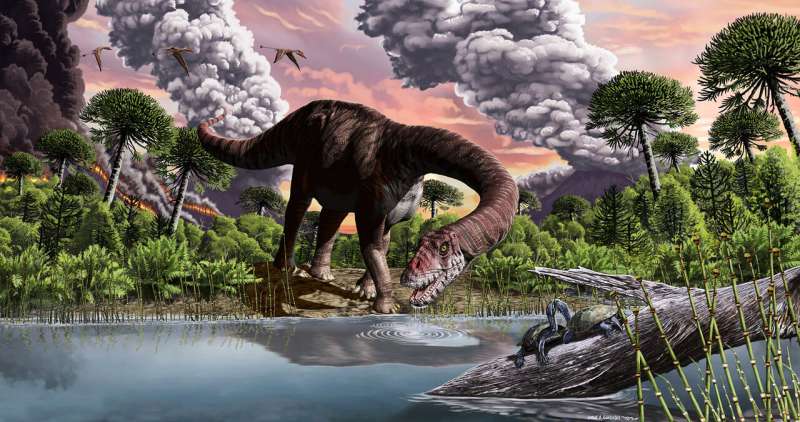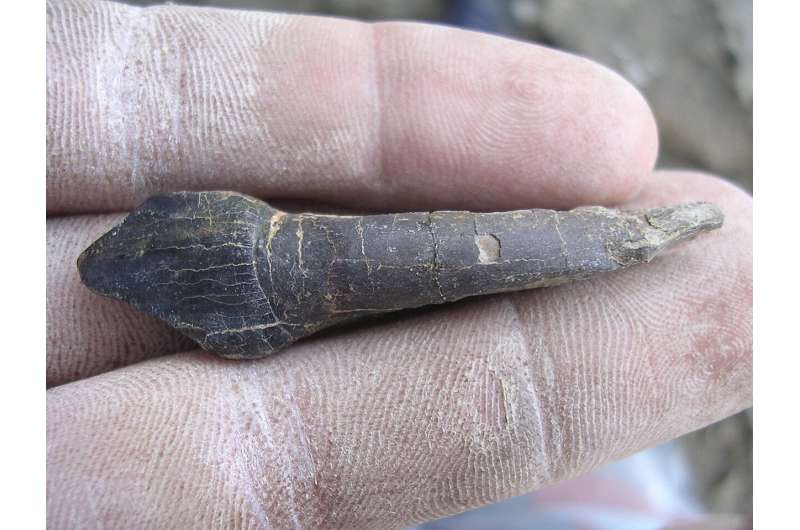Global warming triggered the evolution of giant dinosaurs

The word "dinosaur" tends to evoke giant animals with massive bodies, long necks and tails, and tiny heads. These "quintessential dinosaurs" actually represent one prominent subgroup of the Dinosauria, the so called Sauropoda ("long-necked dinosaurs" in popular culture). Sauropods were truly amazing animals, and included the largest land-living animals known, with body lengths of up to 40 meters and weights of 70 tons or more.
However, these giant animals did not appear directly at the beginning of the era of dinosaurs. For the first 50 million years of their evolutionary history, the Sauropodomorpha—the lineage that the sauropods belong to—were represented by several groups of bipedal to quadrupedal animals. Although some of them reached large body sizes of about 10 meters in length and a few tons in weight, these groups also included smaller, more lightly built animals, some of which were not larger than a goat. Furthermore, all of these animals had slender teeth, indicating that these plant-eating animals fed on soft, lush vegetation. However, toward the end of the Early Jurassic period, some 180 million years ago, all these groups suddenly disappeared, and only one lineage survived and thrived—the sauropods. What caused this faunal change during the Early Jurassic has remained enigmatic so far.
In the Proceedings of the Royal Society B, an international team of researchers led by Argentinean paleontologist Diego Pol and including Munich researcher Oliver Rauhut of the Bayerische Staatssammlung für Paläontologie und Geologie and the Ludwig-Maximilians-University now report new evidence the possible cause of these changes. In the province of Chubut, Argentinean Patagonia, they discovered the fossil remains of one of the oldest large sauropods known, which the team named Bagualia alba, and placedit precisely in its temporal and ecological context. Thus, the layers the new sauropod comes from could be dated to 179 million years ago, just after the mysterious disappearance of the other sauropodomorph groups. Plant fossils in rock layers just before that time and at the time that Bagualia lived provide evidence for the climate and the ecology when these animals lived.

Thus, the data indicate that there was a relative rapid change in climate about 180 million years ago, from a temperate warm and humid climate, in which diverse, lush vegetation flourished, to a strongly seasonal, very hot and dry climate, characterized by a less diverse flora, and dominated by forms showing adaptations for hot climates such as certain conifers. These environmental changes were apparently driven by a greenhouse effect due to climate gasses such as CO2 and methane caused by increased volcanism at that time; evidence of these volcanic eruptions has been found on many southern continents, such as the Drakensberge in southern Africa, for example.
With their slender teeth, the non-sauropodan sauropodomorphs were adapted to the soft vegetation flourishing before this global warming event, but when this flora was replaced by much tougher greenhouse vegetation, these animals died out. The sauropods represented the only group of sauropodomorphs with a much more robust dentition, well-adapted for such tough vegetation, and thus they flourished and became the dominant group of herbivorous dinosaurs at that time. Indeed, the specialization for this kind of vegetation was probably one of the reasons why these animals reached their gigantic sizes: As large digestion chambers are needed to cope with such food, there was a general tendency for these animals to become ever larger.
More information: D. Pol et al. Extinction of herbivorous dinosaurs linked to Early Jurassic global warming event, Proceedings of the Royal Society B: Biological Sciences (2020). DOI: 10.1098/rspb.2020.2310
Journal information: Proceedings of the Royal Society B
Provided by Staatliche Naturwissenschaftliche Sammlungen Bayerns





















